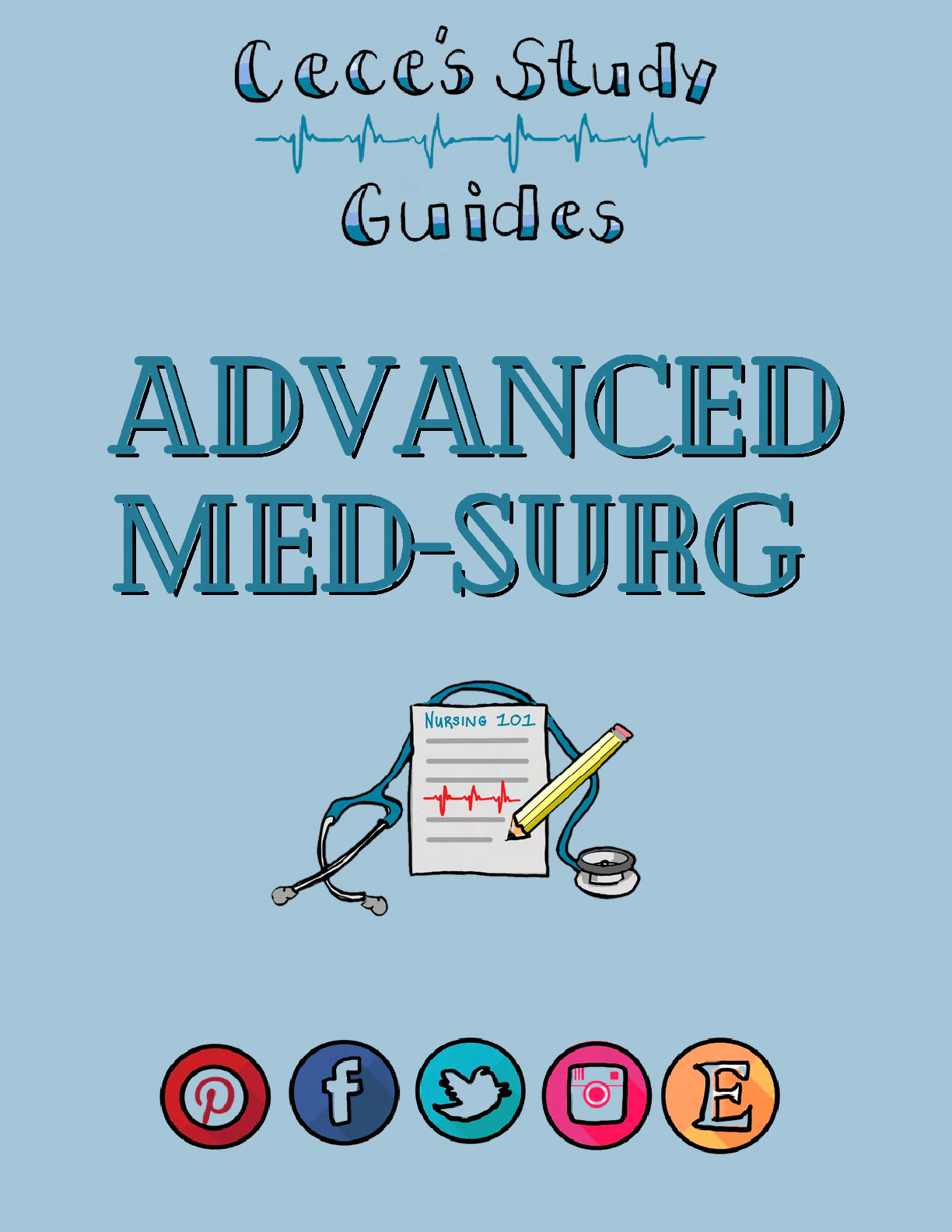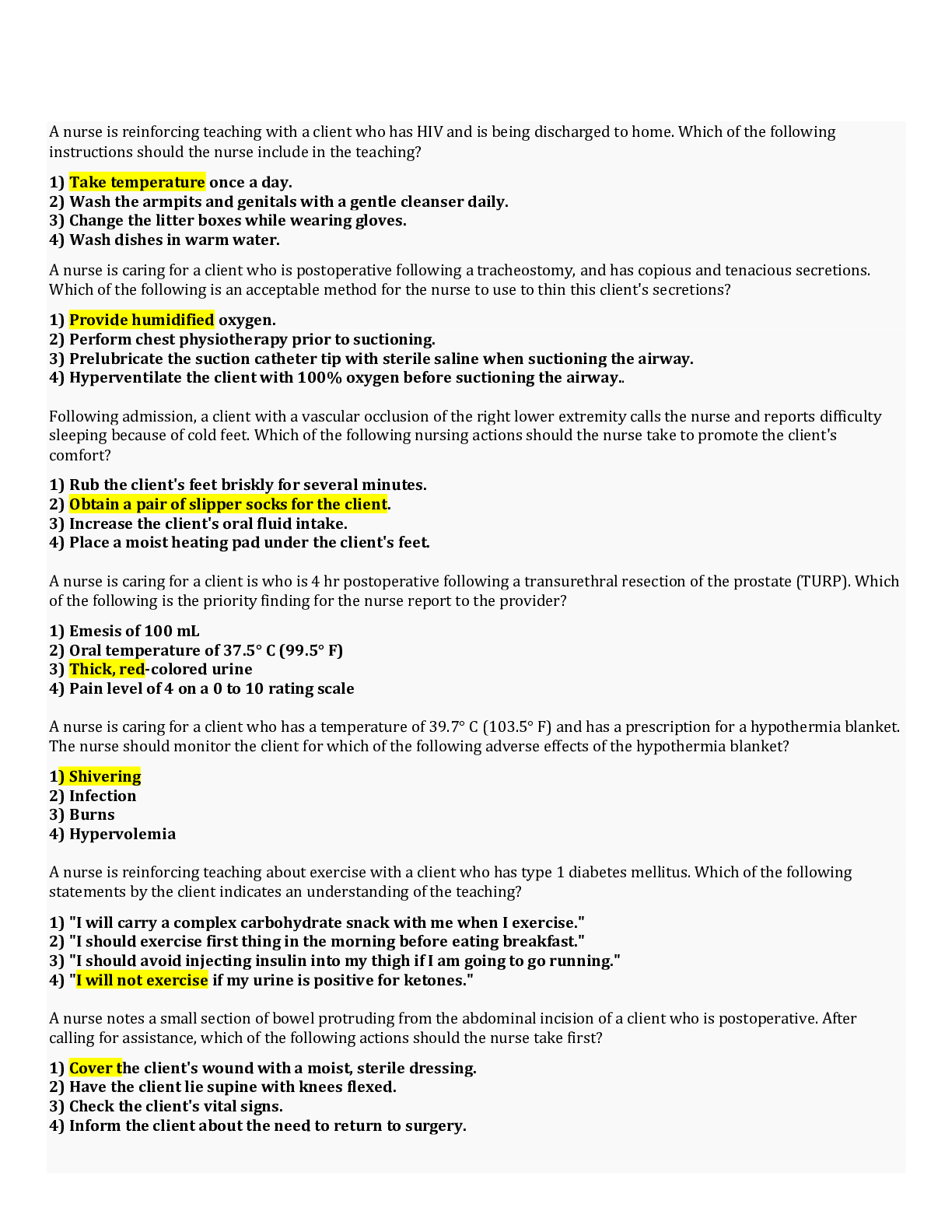Health Care > STUDY GUIDE > AEMT FINAL EXAM STUDY with complete solutions (All)
AEMT FINAL EXAM STUDY with complete solutions
Document Content and Description Below
for consent to be informed, the AEMT must: A. tell the patient where they are being transported. B. explain the risks and benefits of treatment. C. ensure the patient understands the potential cos... t. D. explain local EMS protocols to the patient - ANSWER A. explain the risks and benefits of treatment. even with an EMS certification, your ability to function as an EMT is governed locally by the: A. State health department. B. county health department. C. EMS systems medical director. D. miss systems chief paramedic. - ANSWER C. EMS systems medical director. how did the blood vessels of the skin respond to cold temperatures? A. Constriction, which causes blood to the skin surface. B. constriction, which diverts bought away from the skin. C. dilation, which pulls blood to the skin surface. D. dilation, which diverts but away from the skin. - ANSWER B. Constriction, which diverts blood away from the skin. widespread dilation of the resistance and capacitance vessels causes which type of shock? A. distributive. B. Obstructive. C. Hypovolemic. D. Anaphylactic. - ANSWER A. Distributive. A consistently high level of _____ suppresses the Meehan system by increasing production of interleukin-six. A. Aldosterone B. insulin. C. cortisol D. glucose - ANSWER C. cortisol roles and responsibilities of the EMT include: A. providing definitive care for the patient's condition B. identifying patients who are critically ill or injured. C. performing rapid assessments on all patients. D. diagnosing a patient's condition based on assessment. - ANSWER B. identifying patients who are critically ill or injured. A major risk factor associated with lung cancer is: A. Chronic bronchitis B. exposure to lead C. cigarette smoking D. male gender - ANSWER C. cigarette smoking those types of shock are characterized by: A. reduced cardiac output, circulatory insufficiency, and tachycardia B. tachycardia, flushed skin, and an elevated blood pressure C. bradycardia, pallor, and widespread vasoconstriction D. pulmonary Adema, bradycardia, and widespread vasodilation - ANSWER A. reduced cardiac output, circulatory insufficiency, and tachycardia A young female is experiencing in ectopic pregnancy. This means that the embryo developed: A. in the retroperitomeum B. within the uterus C. outside of the uterus D. in a fallopian tube - ANSWER C. outside of the uterus The transfer of patient care officially occurs when you: A. arrive at the receiving hospital or facility B. complete all documentation regarding the call C. advise the hospital of the situation via radio D. give an oral report to a nurse or physician - ANSWER D. give an oral report to a nurse or physician and example of intravascular fluid is: A. Plasma B. intraocular fluid C. amniotic fluid D. cerebrospinal fluid - ANSWER A. plasma reconstituting a drug, such as glucagon, involves: A. injecting liquid from one vile into another vile that contains liquid medication B. injecting liquid from one vile into another vile that already contains powder C. placing at least 10 ML of Celine into a vile that contains powdered medication D. diluting a medication with at least 20 ML of saline prior to administration - ANSWER B. injecting liquid from one vile into another vile that already contains powder in isotonic solution is one that causes: A. water to flow into the cell B. The cell to swell and eventually burst C. water to be drawn out of the cell D. no change in the shape of the cell - ANSWER D. no change in the shape of the cell how is nitroglycerin usually given? A. Inhaled B. Sublingual C. Orally D. Injected - ANSWER B. Sublingual which of the following medication administration route would result in uneven, unreliable absorption if given to a patient with decreased peripheral perfusion? A. Intravenous B. Intramuscular C. Inhalation D. Intraosseous - ANSWER B. Intramuscular Benzodiazepines are a classification of medication that are used to: A. reduce fatigue B. increase heart rate C. induce sedation D. relieve pain - ANSWER C. induce sedation Which of the following physiologic responses would you expect to occur following administration of a drug that possesses alpha one properties? A. increased cardiac contractility B. systemic vasodilation C. peripheral vasoconstriction D. dilation of the bronchioles - ANSWER C. peripheral vasoconstriction what is the appropriate weight in kilograms of a 155 pound patient? A. 72 kg B. 76 kg C. 70 kg D. 74 kg - ANSWER C. 70 kg during a long distance transport, you initiate an IV of normal saline and infuse 125 ML over two hours. Using microdrip tubing, how many drops per minute is your IV flow rate set at? A. 58 gtt/min B. 53 gtt/min C. 63. gtt/ min D. 39 gtt/min - ANSWER C. 63 gtt/min hey seven-year-old child has swallowed a bottle of aspirin. Medical control orders you to give the child .5 g/kg of activated charcoal. Based on the child's weight of 45 pounds, how much charcoal will you administer? A. 10g B. 20g C. 5g D. 15g - ANSWER A. 10g A 40-year-old female requires a medication to decrease her heart rate. The medication to be administered is supplied in a pre-filled syringe in a concentration of 6 mg/2 ml. how many milliliters are required to achieve a dose of 12 MG? A. 8 mL B. 4 mL C. 2 mL D. 6 mL - ANSWER A known contraindication to the administration of 50% dextrose is? A. inability to follow commands B. Intracranial hemorrhage C. dehydration D. hypertension - ANSWER B. intracranial hemorrhage intracellular fluid and extracellular fluid account for what percentage of total body weight? A. 50% B. 70% C. 80% D. 60% - ANSWER D. 60% adverse reactions associated with epinephrine include all of the following except: A. Anginal pain. B. Bradycardia C. Headache D. dysrhythmias - ANSWER B. bradycardia hey drugs therapeutic index refers to: A. The maximum concentration that can safely begin B. The minimum dose required to achieve the desired effect C. The difference between a therapeutic and lethal dose D. how quickly the drug will be excreted from the body - ANSWER C. The difference between a therapeutic and lethal dose When attaching an and ministration set to a bag of IV fluid and priming the IV tubing, you should ensure that the drip chamber is: A. 1/4 full B. 1/2 full C. 3/4 full D. completely full - ANSWER B. 1/2 full which of the following is not a physiologic effect of sympathetic nervous system stimulation? A. vasoconstriction B. reduced digestion C. dilated pupil D. decreased heart - ANSWER D. decreased heart rate A solution that hydrates the cells while depleting the vascular compartment is referred to as being: A. isotonic B. hyperosmolar C. Hypertonic D. hypotonic - ANSWER D. hypotonic which of the following signs indicate narcotic induced CNS depression and would indicate the administration of naloxone? A. hyperventilation B. violent behavior C. tachycardia D. hypoventilation - ANSWER D. hypoventilation hey 66-year-old male with congestive heart failure presents with pulmonary Adema and difficulty breathing. His blood pressure is 180/90 MM HD and his pulse rate is 110 bpm and irregular. When starting an IV,which of the following, if available, would be most appropriate for this patient? A. intracath B. saline lock C. butterfly catheter D. 14 gauge angiocath - ANSWER B. saline lock in addition to administering supplemental oxygen, what is the most appropriate management for a patient with circulatory overload caused by excessive IV fluid administration? A. Head elevated, medical control notified B. Head lowered, medical control notified C. Trendelenburg position, event documented D. lateral recumbent position, event documented - ANSWER A. Head elevated, medical control notified A micro drip administration set features a small, needle like orifice inside the drip chamber and delivers: A. 10 gtt/mL B. 60 gtt/mL C. 15 gtt/mL D. 100 gtt/mL - ANSWER B. 60 gtt/mL A 40-year-old man with diabetes has a blood glucose level of 38 MG/DL. However, because he is unconscious and unable to swallow oral glucose, that medication is: A. Contraindicated B. indicated C. idiosyncratic D. ineffective - ANSWER A. Contraindicated what is an enteral drug? A. A drug that is administered via the oral route only B. A drug that is given to patients with severe diarrhea C. any drug that is administered along any portion of the G.I. tract D. any drug that is administered via the intravenous route - ANSWER C. any drug that is a minister along any portion of the G.I. tract To minimize the risk of injuring yourself when lifting or moving a patient, you should: A. avoid the use of log rolls or body drags. B. use a direct carry whenever possible C. flex at the waist instead of the hip D. keep the weight as close to your body as possible - ANSWER D. keep the weight as close to your body as possible stimulation of beta-1 receptors causes a positive inotropic affect, resulting in: A. increased cardiac contractility B. increased conduction velocity in the heart C. dilation of the bronchioles in along D. and increased heart rate - ANSWER A. increased cardiac contractility when assessing a patient's abdomen, which of the following techniques will provide you with the least amount of information? A. assessing for aortic pulsations B. visualization for ecchymosis C. gentle palpation of all quadrants D. Auscultation of bowel sounds - ANSWER D. Auscultation of bowel sounds The nearest portion of the adults trachea is the: A. thyroid cartilage B. cricoid ring C. cricoid cartilage D. glottic opening - ANSWER D. glottic opening partial pressure is the term used to describe the amount of gas that is: A. dissolved in fluid B. in arterial blood C. exchanged in the lungs D. in venous blood - ANSWER A. dissolved in fluid The lower portion of the pharynx that opens into the larynx anteriorly in the esophagus posteriorly is the: A. nasopharynx B. hypopharynx C. oropharynx D. larynx - ANSWER B. hypopharynx cheyne-Stokes respirations are characterized by: A. rapid and deep breathing with an acetone breath odor B. rapid and slow breathing with alternating apneic periods C. impaired respirations with sustained inspiratory effort D. irregular tachypnea with occasional periods of apnea - ANSWER B. rapid and slow breathing with alternating apneic periods stimulation of the sympathetic nervous system results in: A. decreased blood pressure and heart rate B. increased blood pressure and heart rate C. vasodilation and a mild heart rate decrease D. vasoconstriction and decreased heart rate - ANSWER B. increased blood pressure and heart rate chemoreceptor send messages to the brain to increased respirations when the: A. arterial oxygen levels increase B. PH of the cerebral spinal fluid increases C. arterial carbon dioxide levels increase D. arterial blood pressure falls - ANSWER C. arterial carbon dioxide levels increase what are the physiologic effects of nitroglycerin when given to a patient with suspected cardiac related chest pain A. decrease Venus pooling of blood and coronary vasoconstriction B. coronary artery dilation and increase systemic vascular resistance C. vascular smooth muscle relaxation and coronary artery dilation D. vascular smooth muscle contraction and increased venous return - ANSWER C. vascular smooth muscle relaxation and coronary artery dilation you are dispatch to the home of a 64-year-old male patient with lung cancer. The patient complains of a cute dyspnea however as long as he is sitting upright, he's breathing is easier. He denies fever, and his breath sounds are decreased over the base of the left long. What is the most likely cause of this patient's symptoms? A. localized bronchospasm in the lungs B. Air in the plural space with long collapse C. Collection of fluid outside of the lung D. consolidation of fluid within the lung - ANSWER C. Collection of fluid outside of the lung ventricular tachycardia often causes hypotension because: A. tachycardia causes widespread vasodilation, which lowers the blood pressure B. blood from the atria fills the ventricles to quickly due to the rapid heart rate C. there is not enough time between beats for the left ventricle to fill with blood D. Afterload increases, which causes the ventricles to work against higher pressure - ANSWER C. there is not enough time between beats for the left ventricle to fill with blood which of the following is not a component of the cardiac electrical conduction system? A. Sinoatrial Node B. Purkinje fibers C. atrioventricular node D. Interatrial septum - ANSWER D. interatrial set when assessing a middle-age male patient with chest pain, you note a large vertical scar in the center of his chest. This indicates that he has most likely had: A. A percutaneous coronary angioplasty B. coronary artery stent placement C. A surgically implanted cardiac pacemaker D. A coronary artery bypass graft - ANSWER D. A coronary artery bypass graft Asystole has an exceedingly high mortality rate because it: A. reflects a prolonged period of myocardial ischemia. B. does not respond favorably to cardiac defibrillation. C. is usually the result of a massive myocardial infarction. D. most often occurs in patients with significant heart disease. - ANSWER A. reflex a prolonged period of myocardial ischemia hey 70-year-old man presents with an acute onset of difficulty breathing that woke him from his sleep. He has a history of hypertension, atrial fib relation, and several heart attacks. During your assessment, you know dried blood around his mouth. The patient tells you that he cannot lie down because he will "smother". What additional settlement findings will you most likely discover? A. diffuse wheezing B. fever and chills C. pulmonary rales D. slow respiratory rate - ANSWER C. pulmonary rales what are the most common signs of an acute hypertensive emergency is: A. acute pulmonary Adema B. A sudden, severe headache C. A posterior nosebleed D. pale, cool, clammy skin - ANSWER B. A sudden, severe headache percutaneous coronary intervention (PCI) is a procedure in which: A. The affected coronary artery is bypassed by way of a graft B. The coronary artery is mechanically cleared via angioplasty C. The coronary thrombus is destroyed with the fibrinolytic agent D. medications are given in order to increase cardiac contractility - ANSWER B. The coronary artery is mechanically cleared via angioplasty typical signs and symptoms of pneumonia include: A. dry cough, high fever, and labored breathing B. weakness, crushing chest pain, and wheezing C. strider, chills, shortness of breath, and fever D. pleuritic chest pain, fever, and rhonchi - ANSWER D. horrific chest pain, fever, and rhonchi The condition in which alveoli collapse is called: A. atelectasis B. bronchitis C. pneumothorax D. Pleuritis - ANSWER A. atelectasis The presence of distended jugular vein's that do not collapse, even when the patient is sitting, is consistent with: A. left side heart failure B. right side heart failure C. an acute hypertensive crisis D. a thoracic aortic aneurysm - ANSWER B. right side heart failure The movement and utilization of oxygen in the body is dependent on all of the following, except: A. effective alveolar-cappillary osmosis B. adequate number of functional erythrocytes C. efficient offloading of oxygen in the tissues D. adequate concentration of inspired oxygen - ANSWER A. effective alveolar-cappillary osmosis common signs of left-sided heart failure include all of the following except: A. tachypnea and tachycardia B. chronic pedal edema C. production of blood-tinged sputum D. increased work of breathing - ANSWER B. chronic pedal edema When the parasympathetic nervous system is activated: A. enhances conduction through the atrioventricular node B. increases the heart rate by increasing SA node discharge C.Slows the heart rate by decreasing SA node discharge D. produces epinephrine and increases cardiac contractility - ANSWER C.Slows the heart rate by decreasing SA node discharge according to starling law of the heart: A. The cardiac muscle can generate its own electrical impulses without outside influence B. damage to the right ventricle causes blood to back up in the systemic circulation C. increased venous return stretches the ventricles, resulting in increased contractility D. decreased venous return reduces the amount of blood delivered to the lungs - ANSWER C. increased venous return stretches the ventricles, resulting in increased contractility Cardiac asthma is a condition in which a patient: A. with congestive heart failure experiences wheezing due to constricted bronchi. B. develops acute respiratory distress when fluid suddenly accumulates in the lungs. C. inadvertently takes too much of his or her beta-blocker, resulting in bronchospasm. D. with a history of asthma develops wheezing caused by an acute cardiac event - ANSWER A. with congestive heart failure experiences wheezing due to constricted bronchi. The exchange of oxygen and carbon dioxide, at the cellular level or in the lungs, is called: A. respiration B. breathing C. ventilation D. oxygenation - ANSWER A. respiration A male patient with a history of congestive heart failure presents with orthopnea. This means that: A. The severity of his respiratory difficulty varies with position B. You cannot breath effectively and less he is sitting up right C. he must live in a supine position in order to breathe effectively D. his respiratory difficulty is severe regardless of his position - ANSWER A. The severity of his respiratory difficulty varies with position A 56-year-old male complains of difficulty breathing. His wife tells you that he complained of chest discomfort a few days prior, but would not allow her to call EMS. Your assessment reveals rales in the apogee and bases of both lungs. This patient's clinical presentation is most consistent with: A. COPD exacerbation B. acute pulmonary embolism C. chronic bronchitis D. Cardiogenic pulmonary edema - ANSWER D. Cardiogenic pulmonary edema when the diaphragm and intercostal muscles contract: A. intrapulmonary and atmospheric pressure's are equal B. intrapulmonary pressure falls below atmospheric pressure C. atmospheric pressure exceeds intrapulmonary pressure D. atmospheric pressure draws air out of the lungs - ANSWER B. intrapulmonary pressure falls below atmospheric pressure A 57-year-old female with a history of peripheral vascular disease presents with an acute onset of confusion, aphasia, left-sided hemiparesis, and facial droop. You should suspect an: A. arterial blockage in the left cerebral hemisphere B. arterial blockage in the right cerebral hemisphere C. arterial hemorrhage in the left cerebral hemisphere D. arterial hemorrhage in the right cerebral hemisphere - ANSWER B. arterial blockage in the right cerebral hemisphere when assessing a patient suspected of overdosing on cocaine, you must be especially alert for. A. Cardiac dysrhythmias B.Significant bradycardia C.Profound hypotension D. Respiratory depression - ANSWER A. cardiac dysrhythmias The hypertension that is commonly observed in patients with an intra-cerebral hemorrhage is usually the result of: A. The body's attempt to shunt blood to the brain B. A reflex bradycardia as the body compensates C. systemic vasodilation caused by autoregulation D. massive vasoconstriction within the - ANSWER A. The body's attempt to shunt blood to the brain patients with a hemorrhagic stroke typically experience a rapidly declining level of consciousness because of: A. increasing intracranial pressure B. blood in the subarachnoid space C. pressure on the brain stem D. Global anoxia of the cerebrum - ANSWER A. increasing intracranial pressure The first stage of disseminated intravascular coagulation (DIC) is marked by: A. uncontrolled hemorrhage B. increased platelet production C. increased platelet aggression D. reduced platelet production - ANSWER A. uncontrolled hemorrhage patients with cyanide poisoning often have breath order that resembles: A. bitter almonds B. wintergreen C. camphor D. acetone - ANSWER A. bitter almonds [Show More]
Last updated: 1 year ago
Preview 1 out of 18 pages
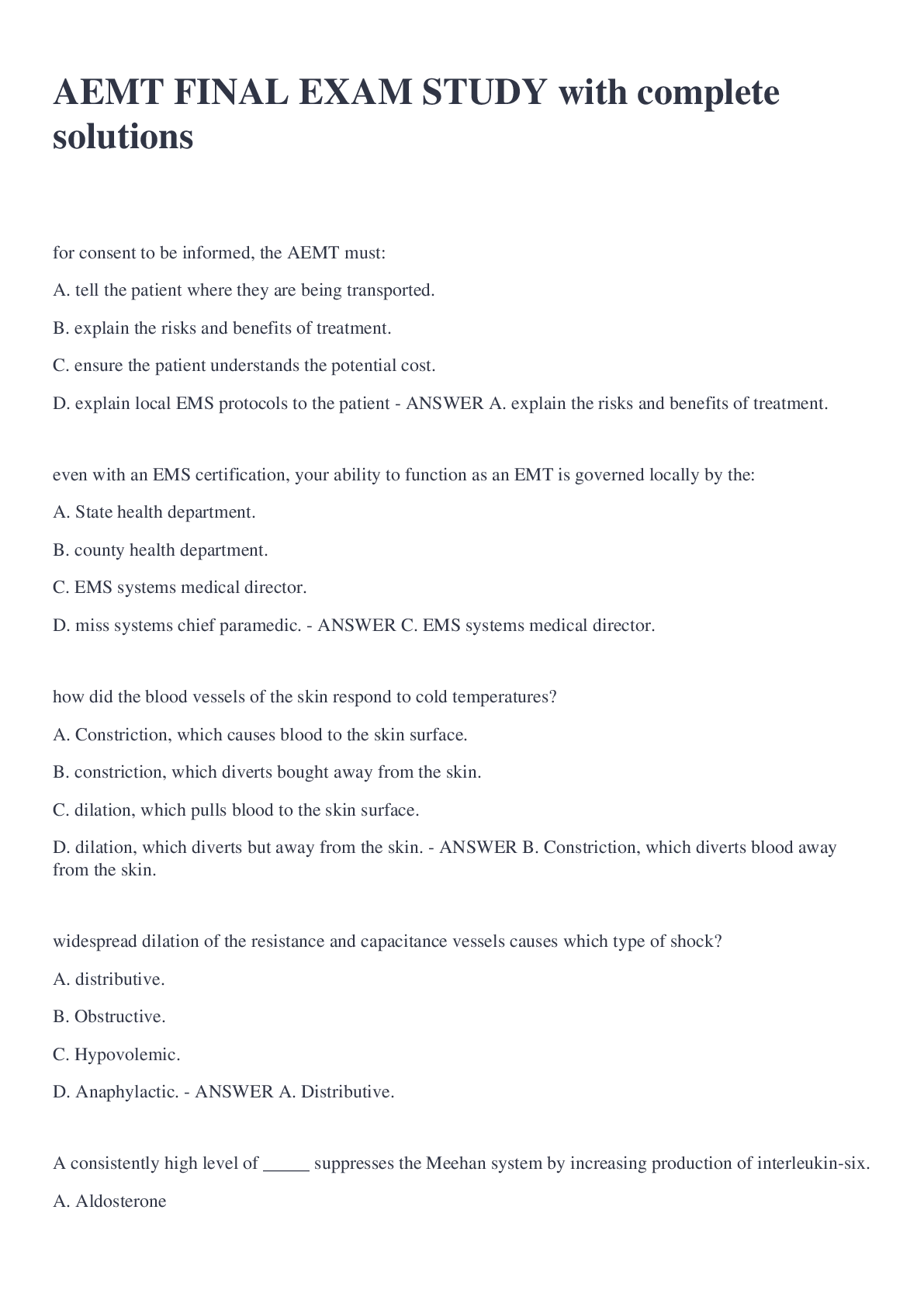
Reviews( 0 )
Document information
Connected school, study & course
About the document
Uploaded On
Sep 05, 2022
Number of pages
18
Written in
Additional information
This document has been written for:
Uploaded
Sep 05, 2022
Downloads
0
Views
29

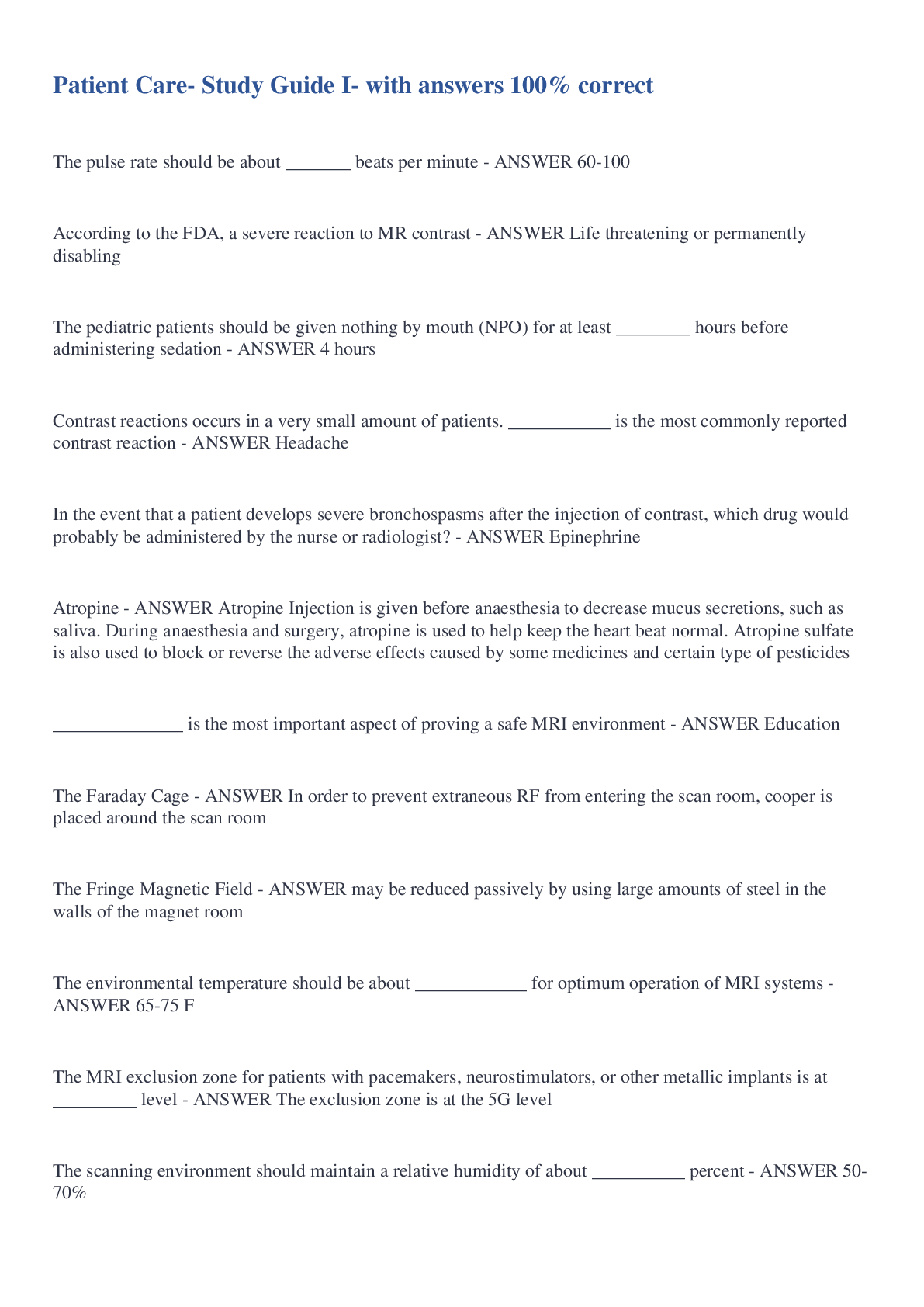
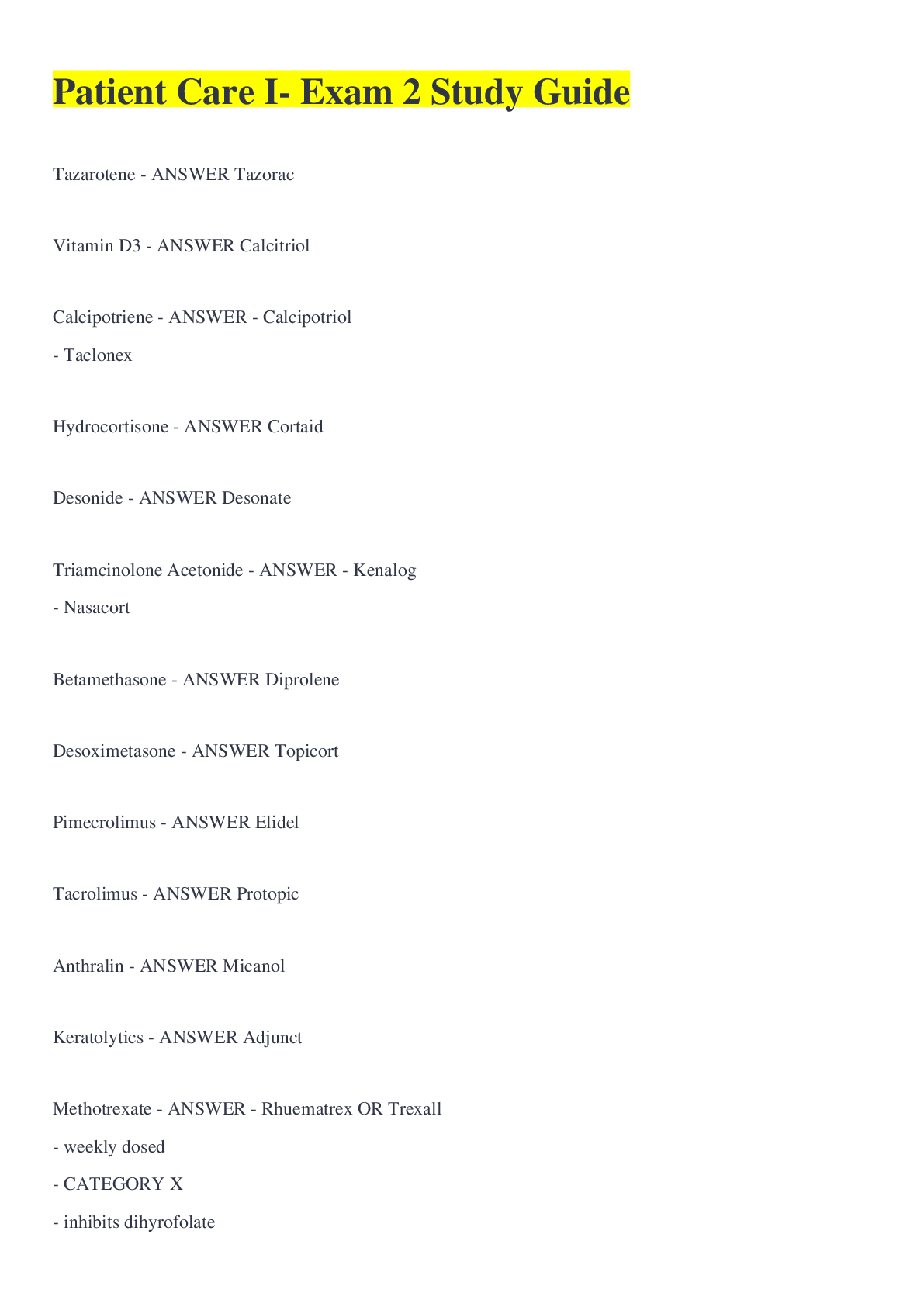
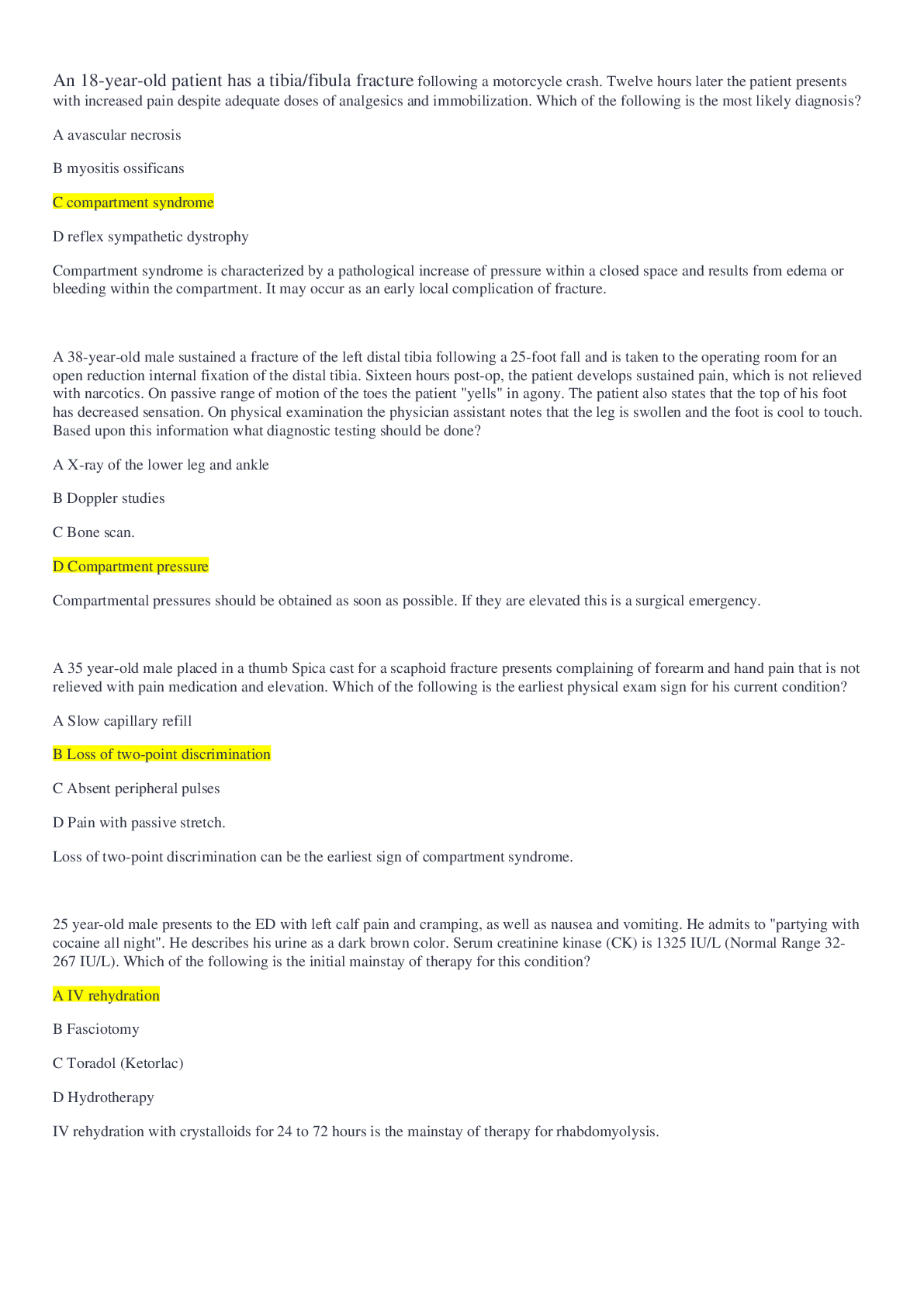
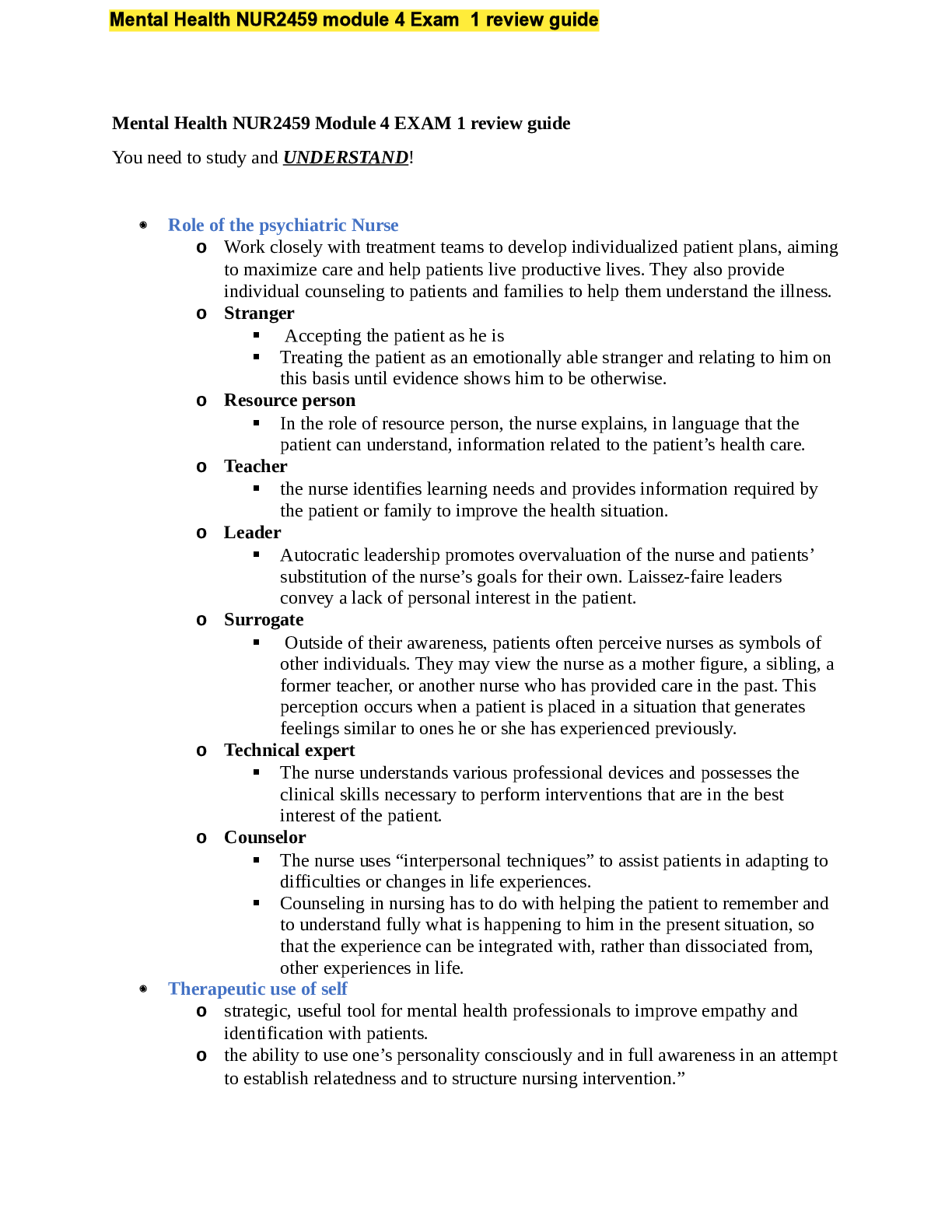
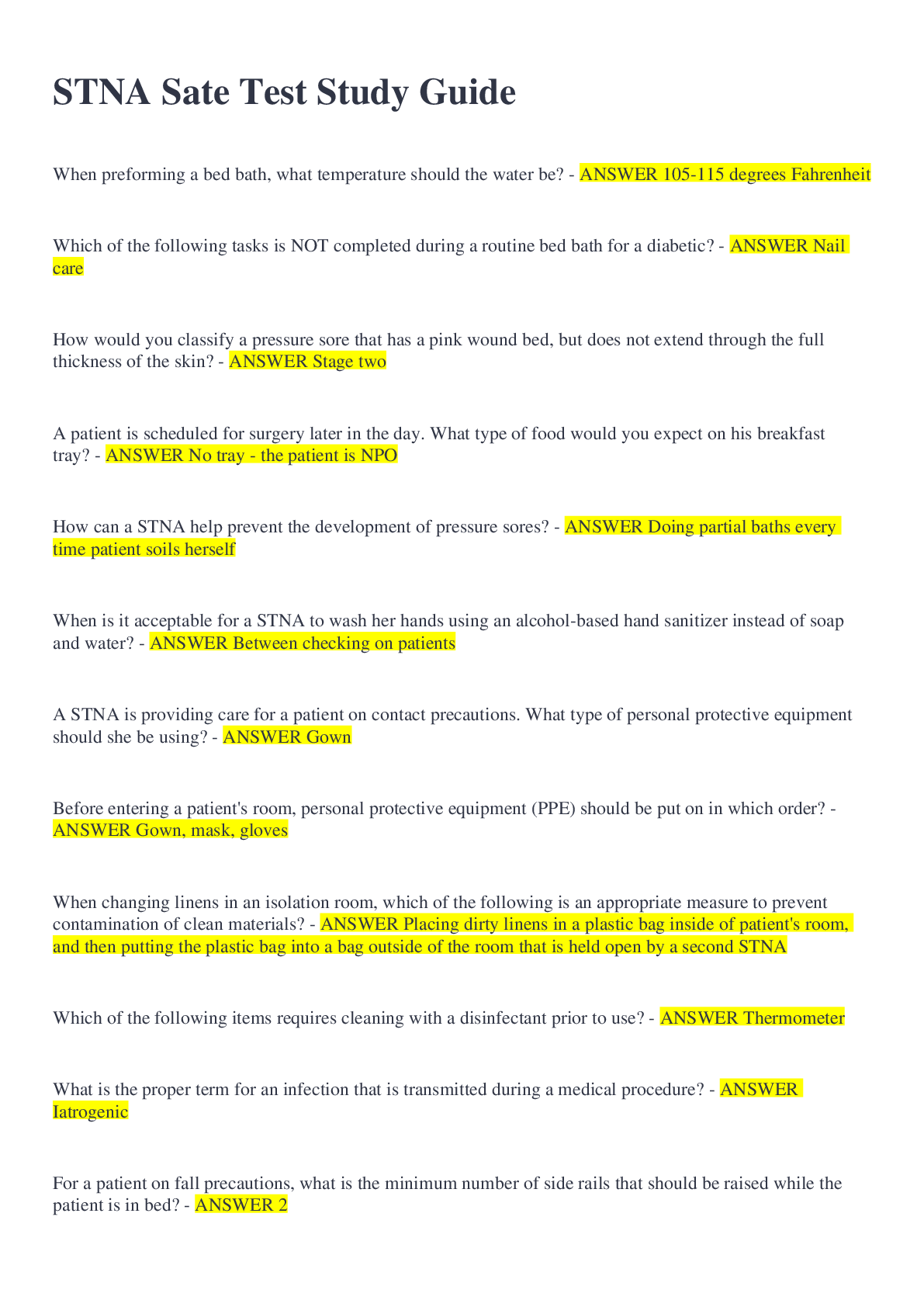
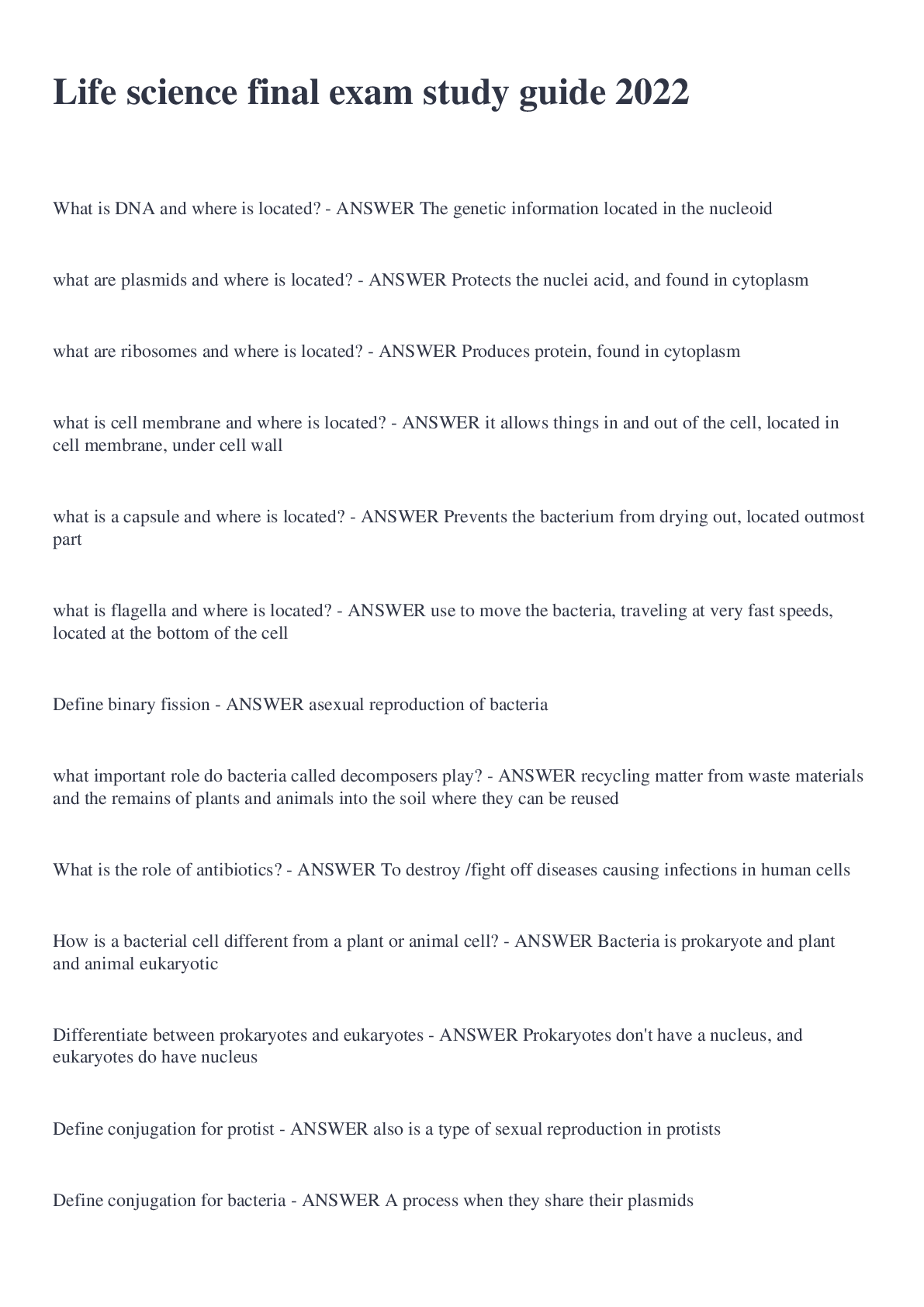
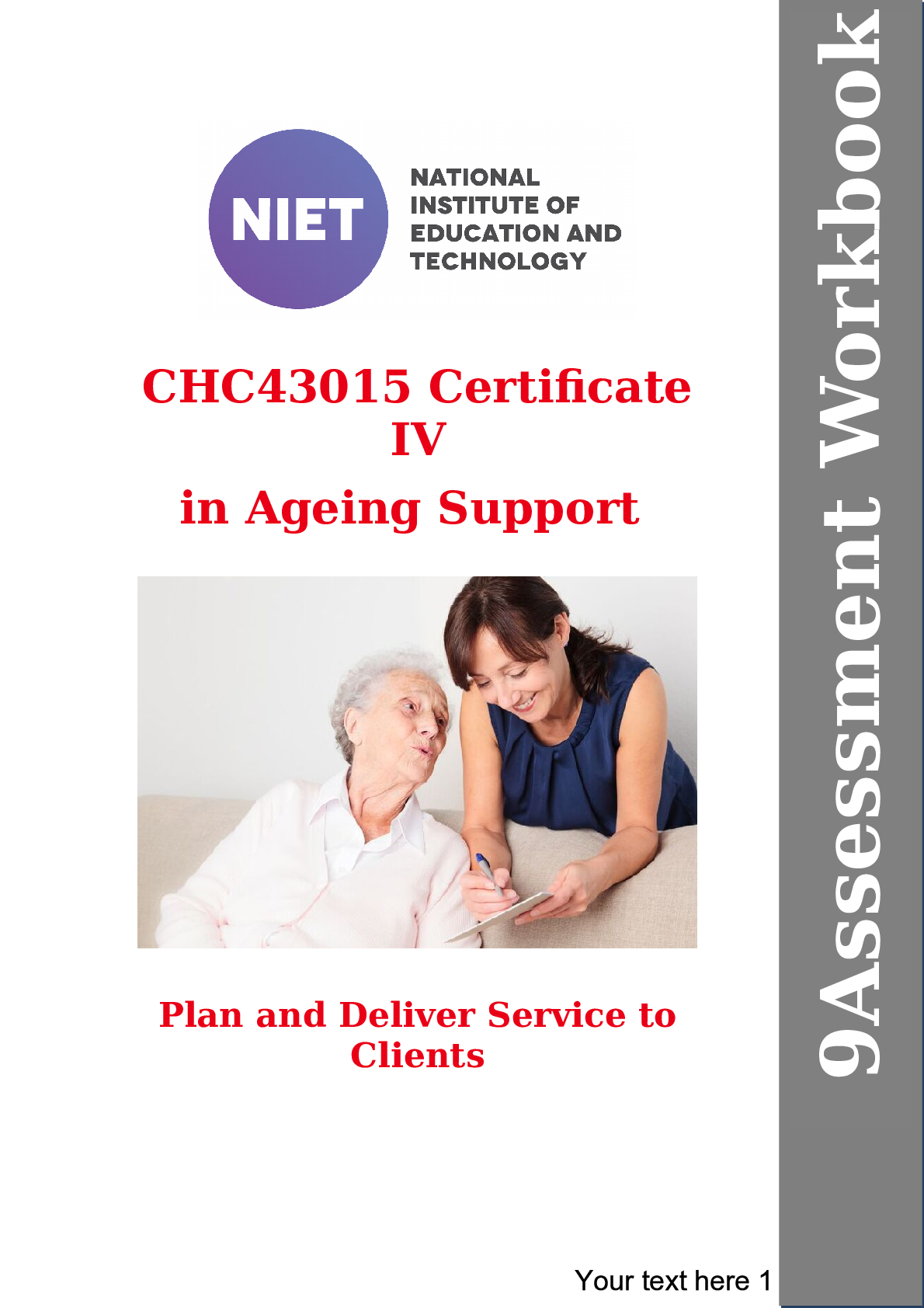
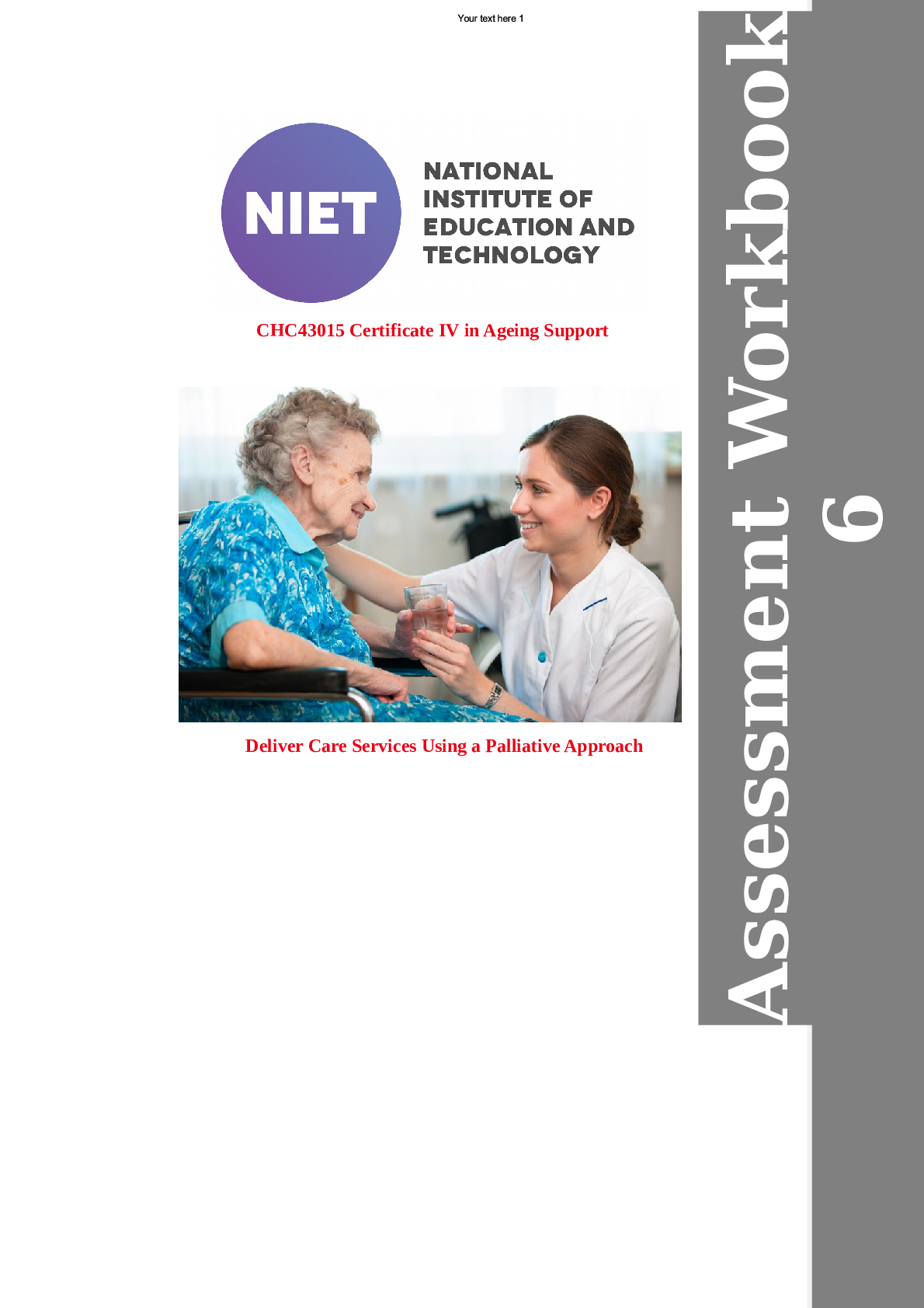
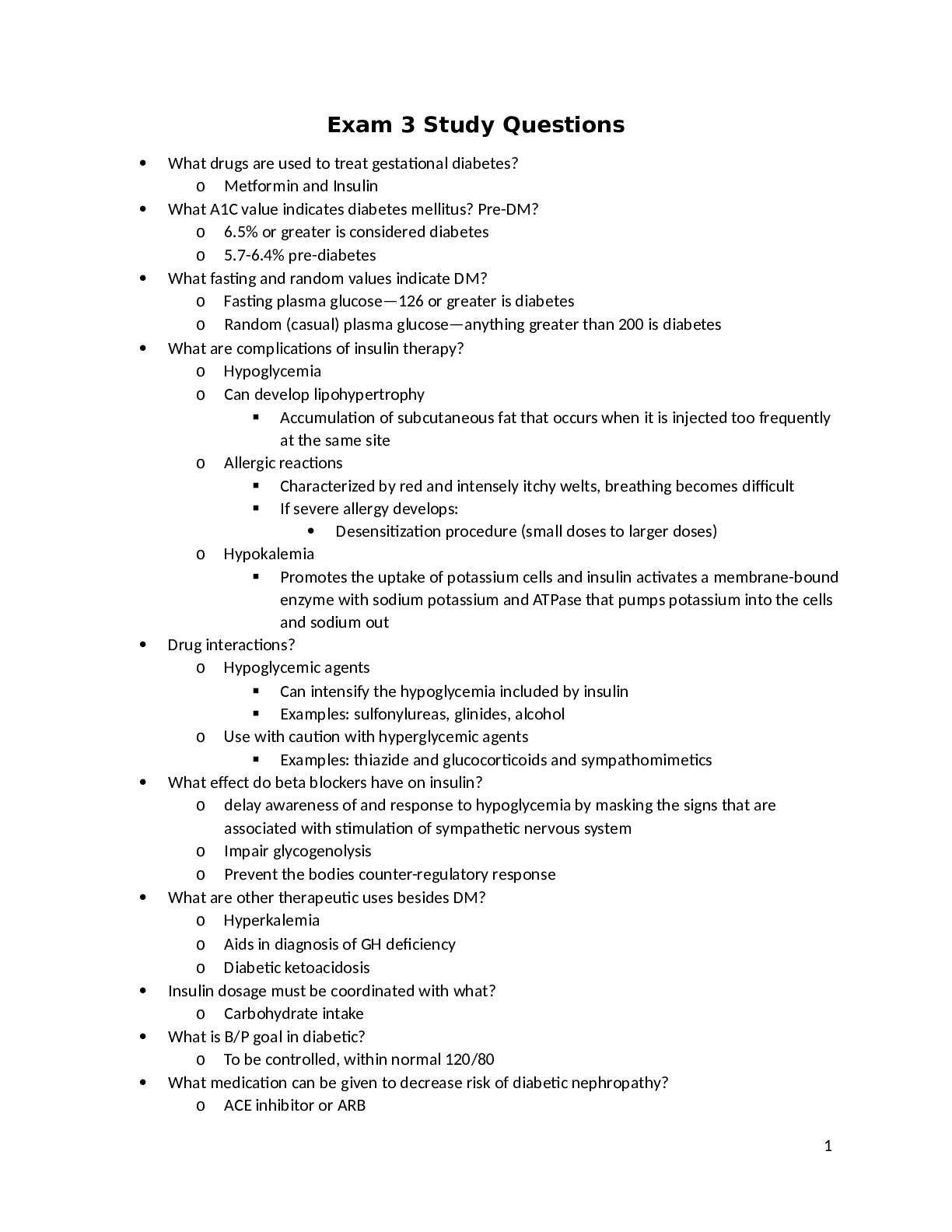
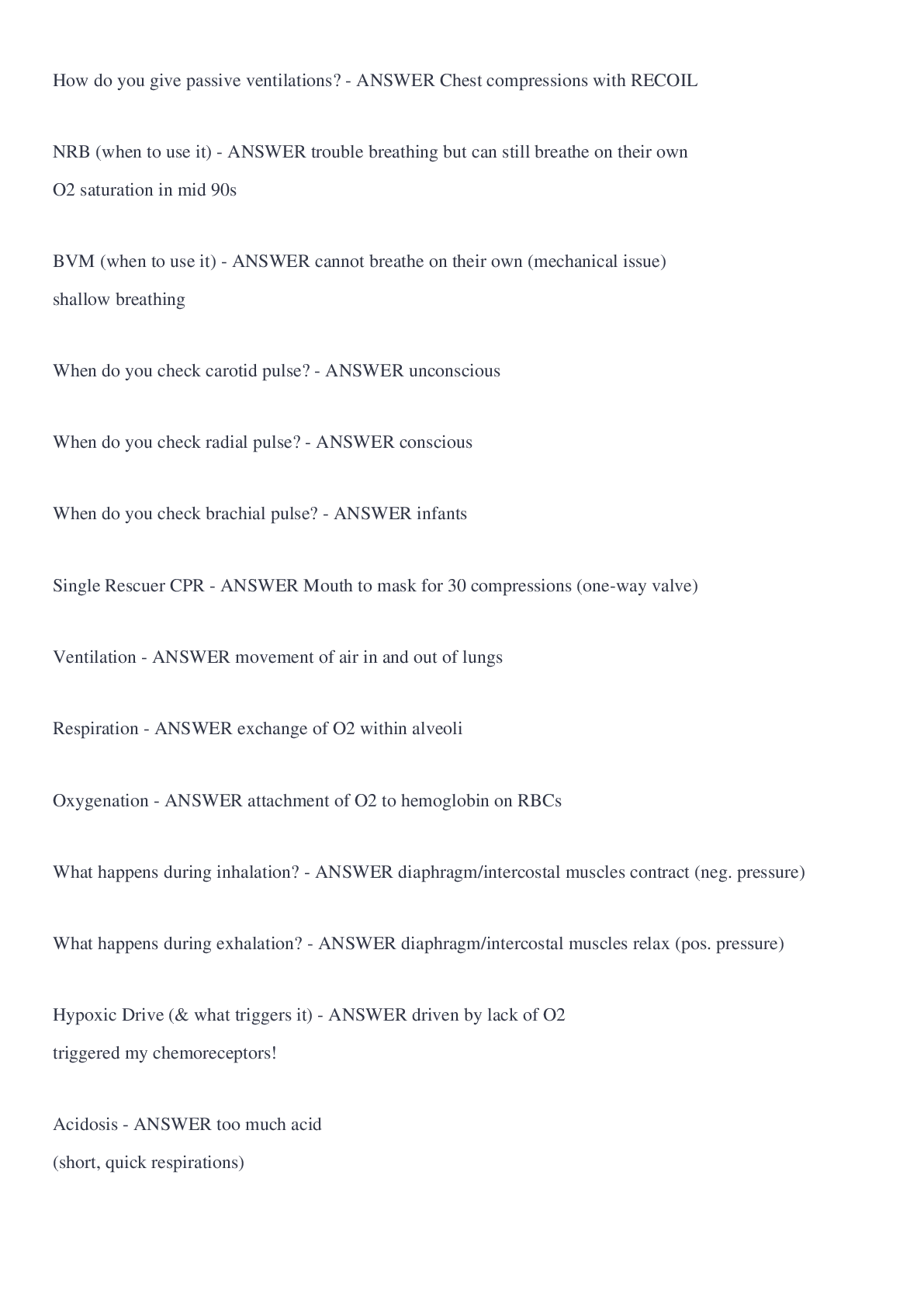
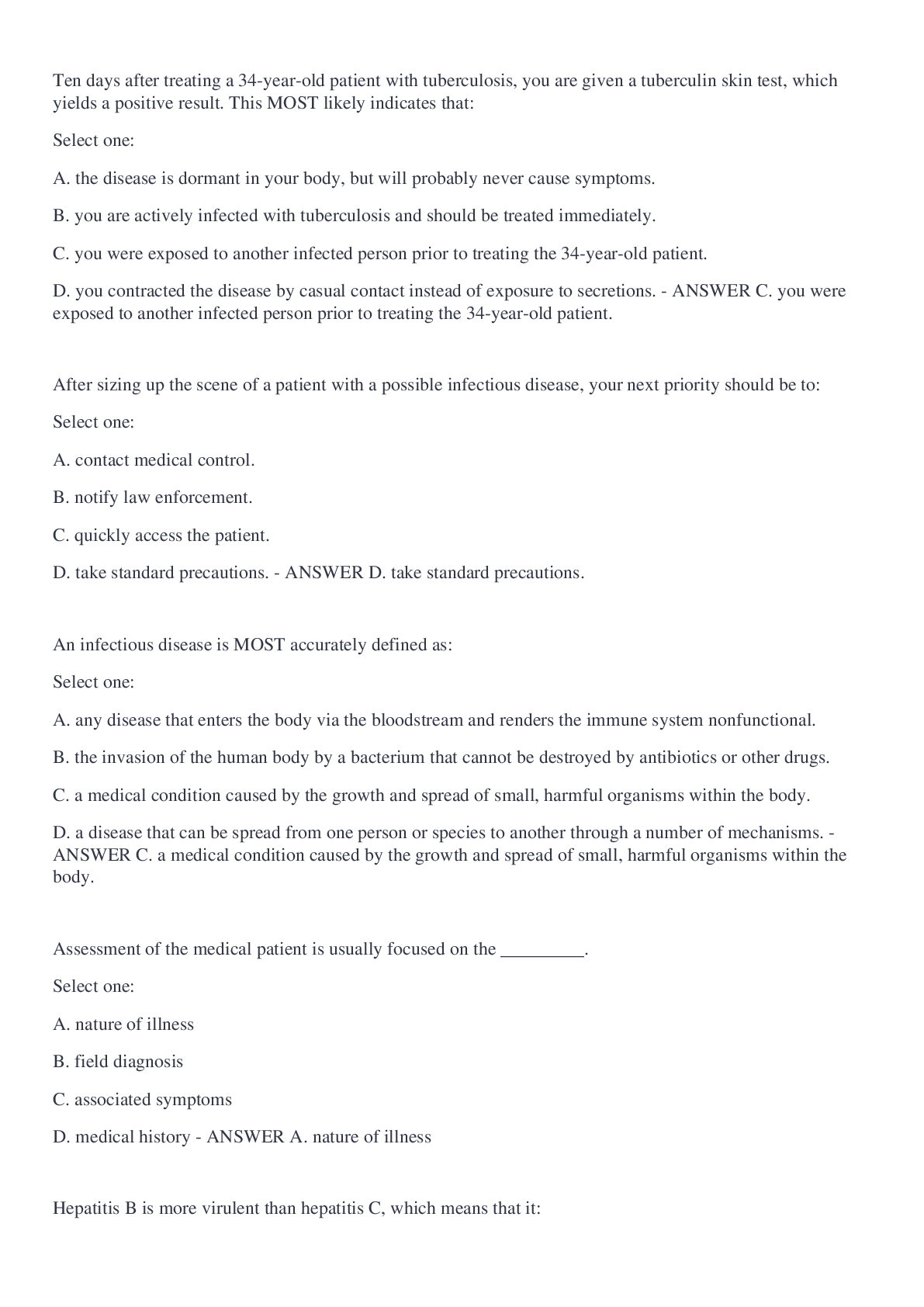
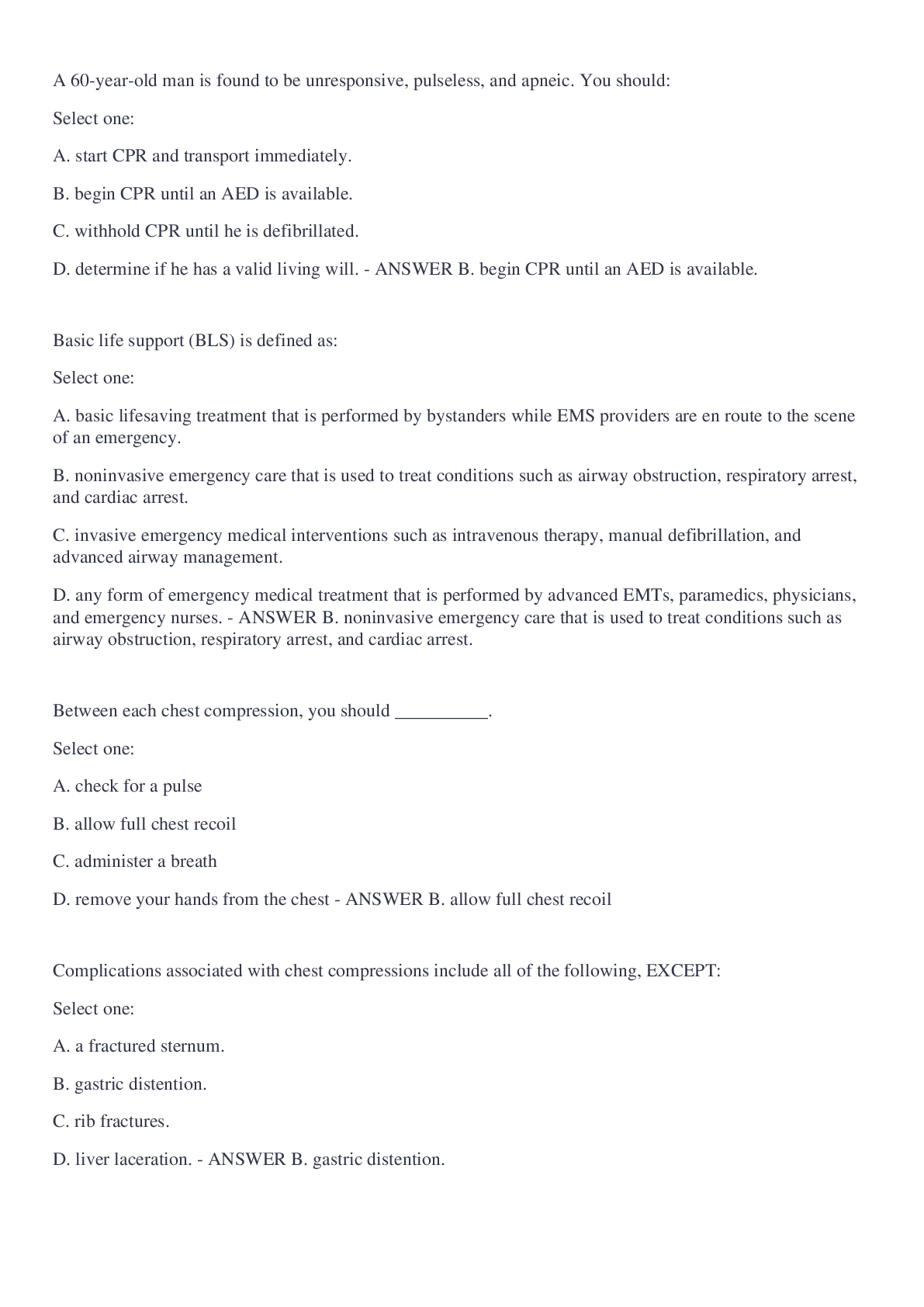
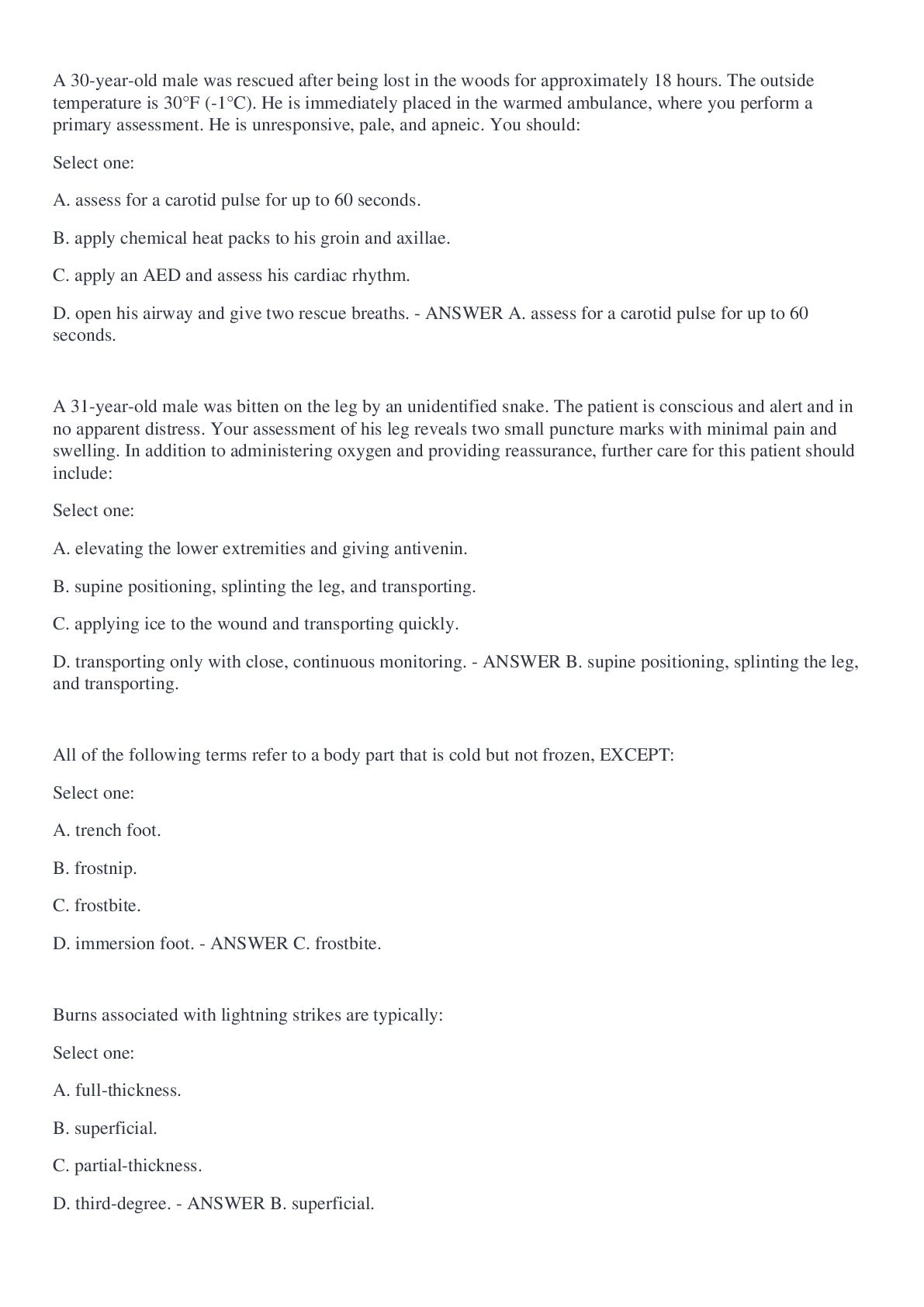
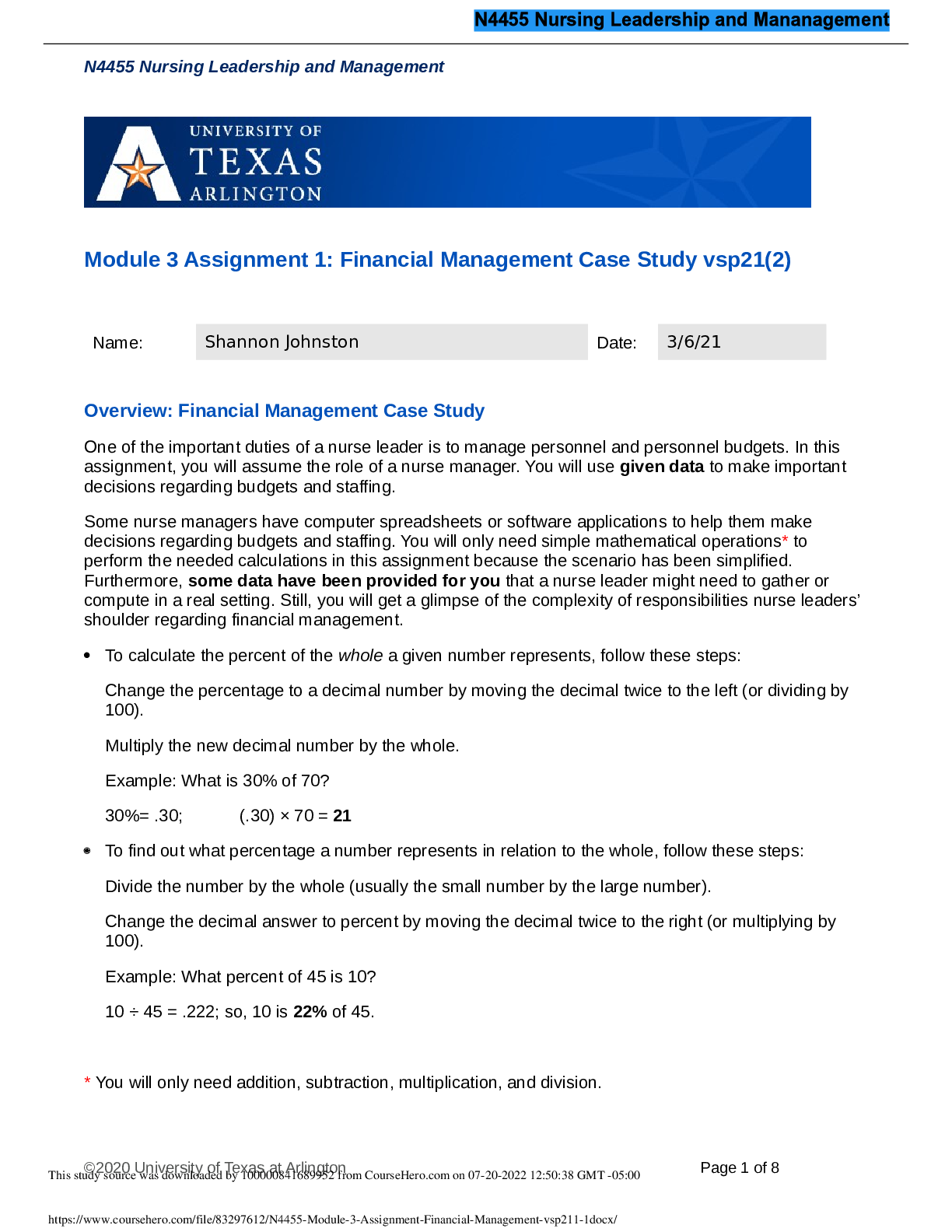
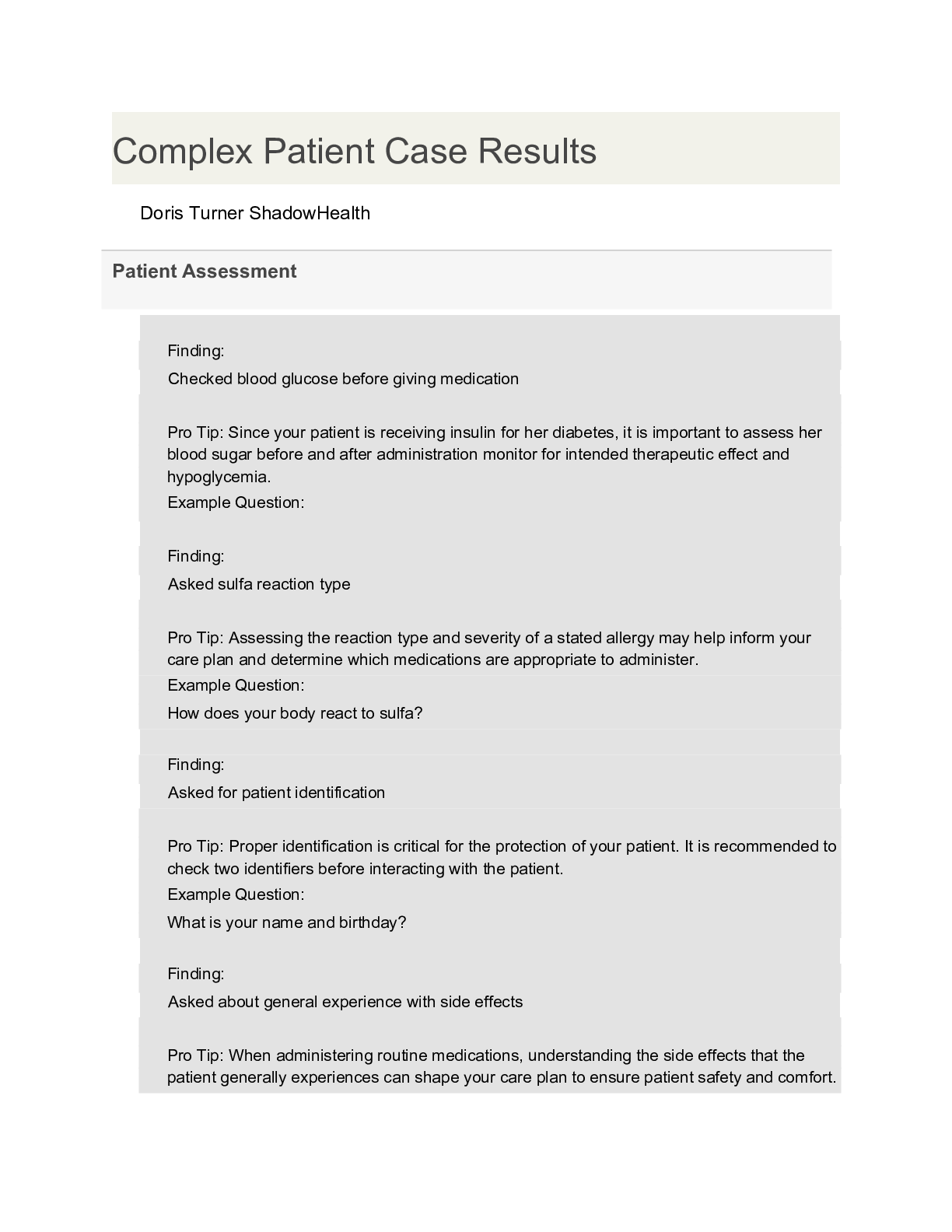







.png)

